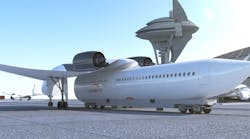by Marie Mawad and Ania Nussbaum
It sounds like something Q, the tech guy in James Bond movies, would create: A plane that lands on a runway, shrugs its wings off, turns into a train and rolls on to rails to drop you off at your local station.
That’s what a French entrepreneur, who’s made millions by connecting engineers with industrial groups, is pitching to Boeing Co. and others. "Link & Fly" is Akka Technologies’s new flagship aircraft design, with wings that come off to hasten turnover at airports and make boarding easier and closer to passengers’ homes.
"After cars go electric and autonomous, the next big disruption will be in airplanes," Akka’s Chief Executive Officer Maurice Ricci said in an interview in Paris. Boeing is among prime customer targets for Akka, as it seeks to limit its dependence on the likes of Airbus SE and Renault SA in Europe.
With Akka’s futuristic concept, passengers would board a train-like tube at a neighborhood station and have their retinas scanned for security during the ride to the airport. Wings would then be attached to the pod for take-off. The company has showcased the idea in a 3D mock-up video, gathering interest from potential customers in Asia, Ricci said, without naming any company.
Disruptive Flights
Plane makers have begun to react as technology companies come up with disruptive ideas -- from Uber’s investments in flying taxis to Kitty Hawk, a startup backed by Google’s co-founder Larry Page that’s creating a battery-powered single-person plane. Airbus took the offensive with a new division to oversee transport of the future, while Boeing has made a noisy foray into jetpacks.
While Akka’s not banking on convincing a plane maker to necessarily build the entire "Link & Fly" concept, it’s betting on the design to be an attention grabber and a showcase, parts of which are likely to end up in customers’ commercial aircrafts down the line.
For planemakers and the companies gravitating around them Asia, and especially China, offer opportunities for new business. Chinese plane builder Comac is developing its own fleet, and could turn to the European aeronautics ecosystem for technology partners.
Akka, which has a market value of 1.1 billion euros ($1.3 billion) and whose biggest shareholder is Ricci, employs engineers that customers can hire on a project basis as consultants. The company developed an autonomous car concept in 2008 and in 2014 partnered with Dassault Systemes to offer services to carmakers.
The stock has risen about 23% this year, multiple times the 1.8% increase in the benchmark CAC 40 Index and a matching jump in the broader SBF120 Index.
U.S. Market
Similar to Airbus’ A320 jet in size and target usage, the Akka Link & Fly carriage for short-range flights carries 162 passengers and the seats can be taken out to move freight instead. With the wings clipped on, and the engines fixed on top, the design has wingspan of about 49 meters, is 34 meters long and 8 meters high.
Akka generates 75% of its sales in France and Germany and became more dependent on auto manufacturing with the takeover of a Daimler engineering unit about seven years ago. The Paris-based company hopes its new concept will woo new aeronautics customers in the U.S. The purchase of Texas-based engineering firm PDS Tech in June is a first step. Ricci expects the acquisition to close in three to six months. "Planes need to become more efficient, less polluting and less noisy," said Ricci. "Our role is to point our customers to technologies of the future."










